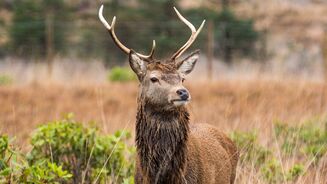Scottish Wildlife
Throughout mainland Scotland, including the Highlands and the Islands, we are so lucky to have such an abundance of wildlife, and whilst on your campervan or motorhome journey you will have the chance of many wildlife spotting opportunities.
There is a huge amount of information out there on the best times and where to stand the best chance of catching your favourite bird or animal but here is a basic guide as somewhere to start and some handy tips.
You can find a wealth of information at Visit Scotland on wildlife found in Scotland but read on for a few of our top tips for wildlife spotting in the Scottish Highlands.

Dolphins
An extremely popular spot is the Scottish bottlenose dolphins. The best time to see dolphins is in the spring and summer months in calmer waters at the change of a tide where they come into feed in the choppy waters. We are lucky to have the coastlines of the Moray Firth on our doorstep. The well-known spot of “Chanonry Point” on the Black Isle is within 30 minutes of Inverness. If you wish to get closer to the action and want to take to the water, there are lots of companies who do boat tours.

Seals
At periods, when the tide is out or at least low, resting seals are visible on the shoreline or on exposed offshore rocks. They are visible year-round all over Scotland but you are most likely to spot them on the West Coast, Orkney, and the Hebrides as well as in the local waters of the Moray Firth. Any of the tour companies above would help you to see them locally to Inverness or if you are on your campervan adventure and wanted to see them whilst touring, here are a few other suggestions.
Skye - Seaprobe Atlantis
Plockton - Calum's Sealtrips

Whales
Minke whales can be found in Scottish waters and are generally 8-9 meters long. They travel singly or with a calf. They are visible in summer and migrate to warmer waters in the winter. They are spotted mostly around the west coast and western islands.
The humpback whale can occasionally be found offshore from June onwards and the killer whale, resident in these waters, may be seen at any time of year. We have recently had sighting of the orca in our waters close to Findhorn in the Moray Firth.

Red Deer
Red deer are Scotland’s largest surviving native wildland mammal. You still find them in their thousands all over Scotland. Stags live in small wandering groups, except during the rut when they become solitary and fight other stags for the control of a hind herd.
Early summer is the best time to watch hinds and calves, as within the herd they are highly sociable. Red deer are more active during the morning and evening but can be seen more often during the long daylight hours of summer. The best time to see stags is during the autumn rut and they are more active in cold weather and rain, wallowing in mud, roaring, and fighting other stags.
If you are unlucky enough to not spot the red deer throughout your road trip you can make a visit to Aberfeldy to the Highland Safaris base, they have a Red Deer Centre on site but also arrange daily tours into the mountains to spot many wildlife species.

Red Squirrels
Scotland’s only native squirrel prefers to live in coniferous trees, particularly Scots Pine. Red squirrels are active by day and are found in upland forests and lowland woodlands throughout Scotland, but they are no longer present in the Central Belt and parts of eastern Scotland because of the introduction of the non-native grey squirrel.
A great site for spotting these beautiful animals is the Glen Affric Nature Reserve, for more information visit Forestry and Land Scotland
You will also be able to also book a tour via Speyside Wildlife.

Birds of Prey
There are so many species that it is easier to refer you to the Wild Scotland as there is an abundance of useful information on all the birds including their habitats and environments.
You can also visit the Osprey centre at Loch Garten, Abernethy or on the Black Isle you can visit the Red Kite Nature Reserve – For more information visit RSPB.
Enjoy building wildlife spotting into your adventure in your motorhome or campervan road trip but remember to respect the land and animals' habitat and environments so that we can all enjoy the wildlife for years to come.
